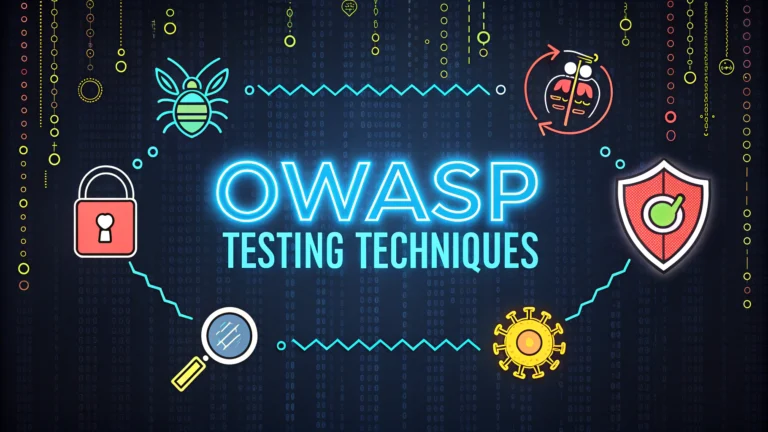OWASP Testing Techniques form the backbone of modern security assessment methodologies.
Quick Overview of OWASP Testing
OWASP (Open Web Application Security Project) provides a structured framework for testing web applications through their Testing Guide v4.
Main Testing Categories:
- Information Gathering
- Configuration Management Testing
- Authentication Testing
- Authorization Testing
- Session Management
- Input Validation
- Error Handling
- Cryptography
- Business Logic Testing
- Client-side Testing
Information Gathering Techniques
- Web Spider/Crawler Tools (like Burp Spider, OWASP ZAP)
- Search Engine Discovery
- Identify Application Entry Points
- Fingerprint Web Server (Nmap, Wappalyzer)
Configuration Testing
- SSL/TLS Testing (SSLyze, TestSSL.sh)
- Database Listener Testing
- Infrastructure Configuration Review
- File Extension Handling
Authentication Testing Tools
| Tool Name | Purpose |
|---|---|
| Burp Suite | Session handling, authentication bypass testing |
| OWASP ZAP | Authentication testing, fuzzing |
| Hydra | Brute force testing |
Practical Testing Steps
- Map the application’s attack surface
- Analyze visible and hidden entry points
- Test authentication mechanisms
- Check authorization controls
- Test session management
- Validate input handling
Regular testing intervals should be established based on application update frequency and risk level.
Common Testing Mistakes to Avoid
- Skipping proper documentation
- Not obtaining proper authorization
- Testing in production without safeguards
- Ignoring business logic tests
Resources and Tools
Access the official OWASP Testing Guide at OWASP Testing Guide.
Join the OWASP Slack channel for community support: OWASP Slack.
Download recommended testing tools from OWASP Tools Portal.
Next Steps
- Set up a testing environment
- Create test cases based on OWASP guidelines
- Document findings using OWASP templates
- Implement continuous testing practices
Testing Methodologies and Frameworks
Risk-Based Testing Approach
- Identify critical assets and functions
- Evaluate potential threats
- Prioritize testing efforts
- Allocate resources effectively
Automated vs Manual Testing
| Testing Type | Best Used For |
|---|---|
| Automated Testing | Repetitive tasks, large-scale scanning, known vulnerabilities |
| Manual Testing | Business logic, complex authentication, custom exploits |
Documentation and Reporting
Essential Report Components
- Executive Summary
- Technical Findings
- Risk Ratings
- Remediation Steps
- Testing Methodology
Conclusion
OWASP testing techniques provide a comprehensive framework for identifying and addressing web application security vulnerabilities. Success depends on:
- Consistent application of testing methodologies
- Regular updates to testing procedures
- Proper documentation of findings
- Balance between automated and manual testing
- Continuous learning and adaptation to new threats
Organizations should integrate OWASP testing into their SDLC and maintain regular testing schedules to ensure robust application security.
Key Takeaways
- Follow structured testing approaches
- Utilize both automated and manual testing methods
- Maintain detailed documentation
- Stay updated with latest OWASP guidelines
- Build security testing into development processes
FAQs
- What is OWASP penetration testing and why is it important?
Penetration testing based on OWASP methodology is a systematic security assessment approach that identifies vulnerabilities in web applications using the OWASP Testing Guide framework. It’s crucial for identifying security weaknesses before malicious attackers can exploit them. - What are the main phases of OWASP penetration testing?
The main phases include Information Gathering, Configuration Management Testing, Authentication Testing, Session Management Testing, Authorization Testing, Data Validation Testing, Denial of Service Testing, Business Logic Testing, and Client-side Testing. - Which tools are commonly used in OWASP penetration testing?
Common tools include OWASP ZAP, Burp Suite, Nmap, Metasploit, Wireshark, Sqlmap, Nikto, and OWASP Dependency-Check for analyzing security vulnerabilities. - What is the OWASP Top 10, and how does it relate to penetration testing?
The OWASP Top 10 is a standard awareness document listing the most critical web application security risks. Penetration testers use it as a baseline to ensure they’re checking for the most common and dangerous vulnerabilities. - How often should OWASP penetration testing be performed?
Organizations should conduct penetration testing at least annually, after significant infrastructure changes, after major application updates, or when new compliance requirements are introduced. - What’s the difference between black box, grey box, and white box testing in OWASP methodology?
Black box testing involves testing without prior knowledge of the system, grey box testing provides partial knowledge, and white box testing gives complete access to application architecture and source code. - How does OWASP penetration testing handle API security?
OWASP testing for APIs focuses on authentication mechanisms, rate limiting, input validation, proper error handling, and ensuring secure communication through encryption and proper token management. - What documentation should be produced after an OWASP penetration test?
Documentation should include an executive summary, technical findings, risk ratings, proof of concepts, detailed vulnerability descriptions, and specific remediation recommendations for each identified vulnerability. - How does OWASP penetration testing address mobile application security?
It addresses mobile security through testing of client-side data storage, communication with backend services, authentication mechanisms, and platform-specific security controls according to the OWASP Mobile Security Testing Guide. - What are the key differences between vulnerability scanning and OWASP penetration testing?
Vulnerability scanning is automated and identifies known vulnerabilities, while OWASP penetration testing includes manual testing, exploitation attempts, and can identify complex security issues that automated tools might miss.







